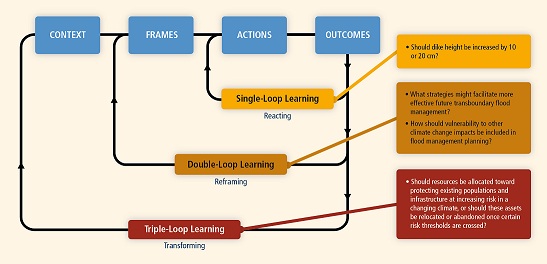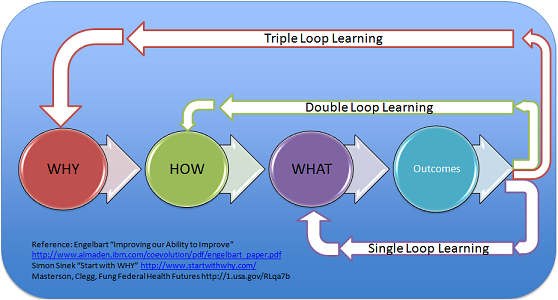Triple-loop Learning (see also Triple-loop Feedback) gains various interpretations depending on context. For example from
http://managementhelp.org/misc/learning-types-loops.pdf Single loop learning is about following the rules.
Double loop learning is about changing the rules.
Triple loop learning is about learning how to learn.
From
http://www.noop.nl/2011/05/triple-loop-learning.html All three levels of understanding are important when building a product. You cannot plan a product release without anticipation [first loop]. You cannot embrace change without adaptation [second loop]. And you cannot deal with the unknown without some exploration and imagination [third loop].
From http://www.thorsten.org/wiki/index.php?title=Triple_Loop_Learning Single-Loop Learning
Single-loop learning assumes that problems and their solutions are close to each other in time and space (thought they often aren't). In this form of learning, we are primarily considering our actions. Small changes are made to specific practices or behaviors, based on what has or has not worked in the past. This involves doing things better without necessarily examining or challenging our underlying beliefs and assumptions. The goal is improvements and fixes that often take the form of procedures or rules. Single-loop learning leads to making minor fixes or adjustments, like using a thermostat to regulate temperature.
Are we doing things right? Here's what to do—procedures or rules.
Double-Loop Learning
Double-loop learning leads to insights about why a solution works. In this form of learning, we are considering our actions in the framework of our operating assumptions. This is the level of process analysis where people become observers of themselves, asking, “What is going on here? What are the patterns?” We need this insight to understand the pattern. We change the way we make decisions and deepen understanding of our assumptions. Double-loop learning works with major fixes or changes, like redesigning an organizational function or structure.
Are we doing the right things? Here's why this works—insights and patterns.
Triple-Loop Learning
Triple-loop learning involves principles. The learning goes beyond insight and patterns to context. The result creates a shift in understanding our context or point of view. We produce new commitments and ways of learning. This form of learning challenges us to understand how problems and solutions are related, even when separated widely by time and space. It also challenges us to understand how our previous actions created the conditions that led to our current problems. The relationship between organizational structure and behavior is fundamentally changed because the organization learns how to learn. The results of this learning includes enhancing ways to comprehend and change our purpose, developing better understanding of how to respond to our environment, and deepening our comprehension of why we chose to do things we do.
How do we decide what is right? Here's why we want to be doing this—principles.
From http://ipcc-wg2.gov/SREX/report/report-graphics/ch1-figures/ in the context of flood management

And from "FEDERAL HEALTH FUTURES SUMMIT LEADERSHIP LEARNING for TRANSFORMATIONAL CHANGE. " September 10-11, 2012 Washington DC Metro Region

The last figure is of importance to us; it represents an interpretation of the triple-loop learning cycles in terms of What, Why, and How.